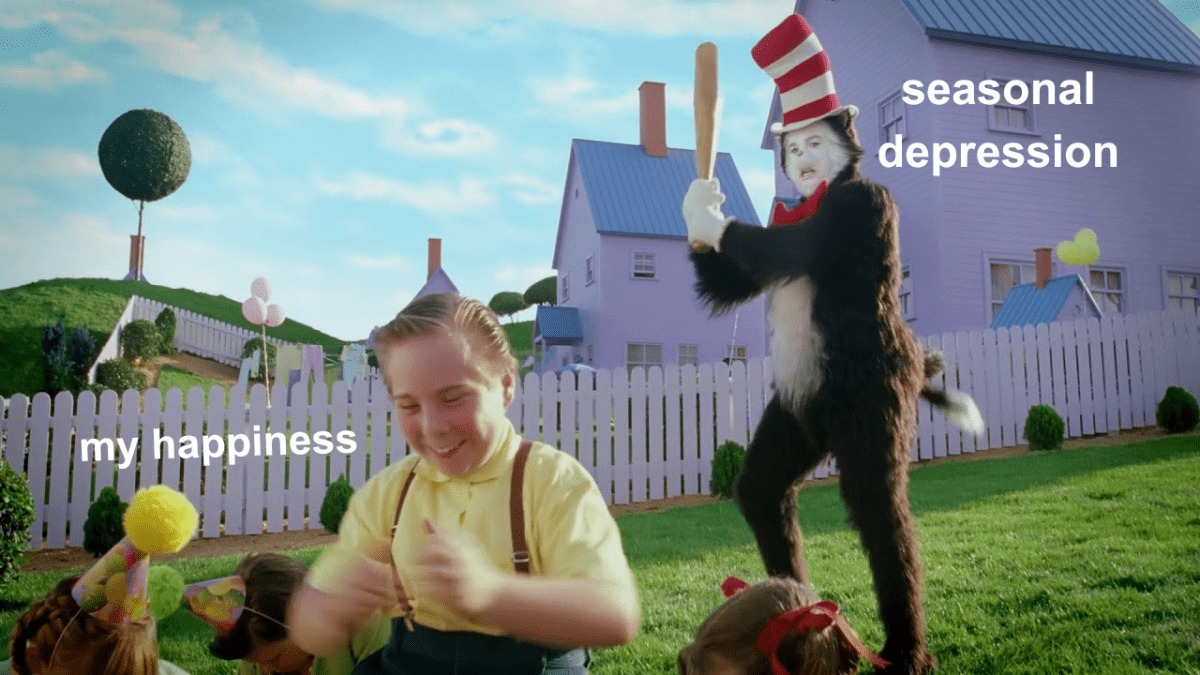
CONTENT WARNING: This article discusses mental health issues.
Every winter, I get sad. It’s pretty much inevitable at this point. When I start to see the autumn leaves drop, it’s pretty easy to start freaking out with the understanding of what’s hurling towards me. Good ol’ seasonal affective disorder.
For those not in the know (lucky bastards), seasonal affective disorder (SAD) is a type of depression that’s largely dependent on the seasons. Now, let’s get one thing straight: me and depression are besties. Have been since high school. But when winter hits and the cold weather soaks in, it reaches a totally new level.
Y’know the one: not leaving your bed for weeks because it’s too cold outside. Not wanting to do anything in general. Sleeping all the time. A wee bit of crying if you’re lucky, but it’s mostly an overwhelming fog of numbness and nothingness that sticks around for 90 days, give or take. Sounds fun, right?
At the moment, it feels like so many of us have a serious case of the sads going on. Hell, I’m in Sydney where I’m soaked in sunlight most of the time and I still have it. Thoughts and prayers for all my Tasmanian and Victorian hotties who are truly going through it right now.
To help us kick seasonal affective disorder to the curb, we’ve enlisted the help of a psychologist. Ahead, the tea on seasonal depression and how to kindly tell it to fuck off.
Alrighty, what TF is seasonal affective disorder?
Carly Dober, Psychologist and Headspace App’s Mental Health Expert told PEDESTRIAN.TV that seasonal depression is the same thing as regular old depression, but people will get it based on the seasons — and likely at the same time every year.
If you’re experiencing seasonal depression, you’ll find that during the autumn and winter months, you’ll feel sad, lack energy, lose interest in activities you used to find fun and oversleep. Basically, it’s like a winter edition of depression. Worst limited edition ever.
It’s most often experienced during colder and gloomier months, but people in warmer climates have also been known to experience it in summer and springtime, she tells me. “This might be in part due to the increase in humidity, leaving people tired and lethargic. Increased humidity, heat and pollen are likely to be the cause of summertime blues.”
But who’s prone to developing seasonal affective disorder? Well, there are a few people who might be susceptible.
“Risk factors for developing SAD include having a family history of SAD, already having depression or bipolar disorder, low levels of Vitamin D, living far from the equator, and shift workers who already can experience minimal daylight,” Carly says.
I’ve got three out of five! What do I win?!
But I live in a sunny place. Why am I so sad all the damn time?
As someone who lives in Sydney where things are sunny as shit all the time, I must admit that I felt kind of silly for getting seasonal depression. Like it was almost reserved for those with really shit weather, like Melbourne (sorry, hotties).
But now I’m finding a bit more solace in the understanding that it’s normal to feel sad as fuck in the winter, even if you’re getting plenty of Vitamin D (no, not that kind Sally).
“People can still be vulnerable to developing SAD in warmer climates — it is all relative,” Carly says.
“Our best research thus far states the lack of sunlight in comparison to longer sunny days is likely to be the main culprit for people experiencing SAD.
“Cold weather can also trigger this, as people are more likely to stay indoors more, socialise less, and move less (all things that can behaviourally mimic many symptoms of depression).”
Tick, tick and tick.
Bad news: climate change will probably mean more people will suffer from seasonal depression
If you’re one of the lucky few who hasn’t experienced SAD, I’ve got some bad news for you, babes. You might be soon to join our exclusive sadcase club thanks to that little jerk called climate change.
Climate change is absolutely going to impact how people experience SAD,” Carly told PEDESTRIAN.TV.
“We know there are going to be more extremes in temperatures, more hot days, more rainy days, and more intense cold days.
“That combined with intensifying climate drivers La Nina and El Nino means that we need to be adept at spotting SAD in ourselves, and others, in order to put into place helpful management and prevention skills when and where necessary.”
Cool, is there anything you don’t want to fucking ruin, climate change?
How do I treat seasonal affective disorder?
When we’re talking about SAD (an apt acronym, if you ask me), the suggested treatment plan tends to be pretty, well, shit. “Just go in the sun!”, people would say to me. Babes, I can’t get out of bed. How do you expect me to hurl myself into THE SUN???
But Carly gave me some actually helpful tips. So here’s how to kick SAD to the curb and tell it to eat a bag of dicks.
1. Get sunlight as early as possible
Please don’t hit me. I promise this tip is actually useful.
“It is important to get moving and get some sunlight in your day as early as possible,” Carly told PEDESTRIAN.TV.
“Natural light when possible is really important in regulating our bodies’ internal body clock and brain chemicals.”
My hot tip: as soon as I wake up, I open my blinds. That way if I feel like being a sadcase in my bed that morning, I can do so while also basking in the sunlight and doing me a little bit of good.
2. Get moving
If you manage to make it out of bed (go, you good thing!), it might be a good idea to try leaning into the cold instead of pressuring yourself to do all the fun exercise activities you would usually do in the warmer weather.
“Try leaning into the cold and having new experiences that you haven’t had before,” Carly says.
“Are you able to go on a winter hike somewhere? Or try going snowboarding or skiing with friends for the first time (or again)? Are you open to trying cold water swimming?
“Movement is another important health management factor, and if you’re able to tie this in with new or fun experiences, it will go a long way.”
For me, this means ditching the hardcore boxing sessions I’ll usually pump out in the summer when everything is bright and cheery and perfect.
Instead, my winter and seasonal depression exercise routine is stripped back. My only rule is that it needs to be gentle and feel effortless. Walking to the coffee shop? That’s exercise, boo. Doing a little 20-minute Yoga With Adrienne session in your lounge room? How good! Any movement is good movement.
3. Practice mindfulness
“You could also start a new habit that trains your brain, such as mindfulness meditation,” Carly says.
I’d always written off mindfulness as something that only cool yoga girls who could do handstands would do. Unsurprisingly, that is not me.
But after actually giving it a go, I’m kind of annoyed at how much mindfulness and guided meditations have helped me, if not to just settle into my yucky feelings and accept them whole.
“You’d be surprised at how quickly you can train yourself to have some distance from your thoughts with practice.”
Mindfulness sessions before going to bed have helped me feel more rested and less sad (does anyone else just cry incessantly when they’re tired? Good).
When I wake up, I’ll also try doing a quick five-minute session to ground me before I start my chaotic day. I know it sounds very woo-woo, but it works.
Take this knowledge and use it to tell that jerk seasonal depression who’s boss! (You are! That’s who!). Remember: we’re almost halfway through winter already and this will be over soon.



